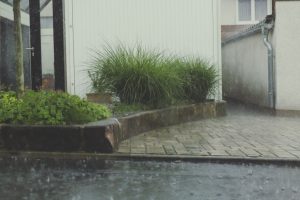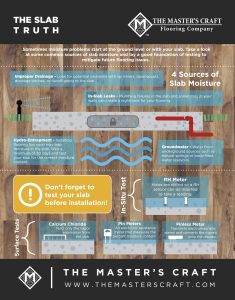Even under the best conditions, there are few things more aggravating to a new homeowner than moisture problems in the home.
Most consumers never really think about this until a problem has arisen. Your realtor would likely not be the one to point out issues with the poor grade of property or existing drainage issues.
 Problems such as pooling ground water near the house, improper drainage from your neighbor’s property, or from a nearby ditch could mean the difference in a dry undamaged home.
Problems such as pooling ground water near the house, improper drainage from your neighbor’s property, or from a nearby ditch could mean the difference in a dry undamaged home.
When building a new home, it is imperative to ask a lot of questions and make no assumptions about the level of expertise or knowledge of the contractors who work for you. There is an element of basic logic to employ when thinking about water and its effects. Believe me, if something doesn’t seem right, it’s probably not.
So, how can outside moisture conditions affect my flooring you ask?
Aside from the comfort and satisfaction a home can bring your family, one of the most important functions this investment provides is a warm and dry place out of the elements. So much time, energy, and money is spent to keep your home comfortable that many actually overlook it as one of its primary roles. Moisture can be destructive depending on its source and force; from a misdirected drainage ditch to a damaged sprinkler head. These seemingly small problems can compound and eventually cause damage if left unattended.
Some common causes of moisture that can adversely impact your flooring can be traced to these areas:
-
- Improperly routed drainage ditches or trenches directing runoff toward not away from the foundation.
- Guttering that is clogged up due to leaves and debris, or where gutters are not extended at least 4 feet out from the home’s foundation.
- Misdirected automatic lawn sprinklers can deposit dozens of gallons of water at the foundation.
- In-slab plumbing breaks or leaks.
- Hydro-Entrapment: Concrete slabs that have not been allowed to properly dry and cure.
Most of these sources for moisture can quickly be remedied with some guidance from specialist in moisture mitigation and remediation. Paying closer attention to routine seasonal home maintenance will go a long way in eliminating some problems before they happen. Cleaning gutters several times during the autumn and winter months and observing the water runoff and drainage from your gutters can help identify potential ground water runoff problems before they cause damage. Before turning on the lawn sprinklers in spring, observe each sprinkler head’s trajectory and coverage zone. Make sure that those located close to the house are not directed at the walls or foundation of your home. These are just a few areas outside the home that can be easily checked.
How Do I Know if Moisture is Affecting My Floor?
Moisture issues can exhibit several obvious and some not so obvious signs. From discoloration between boards to odd bubbles or peeling in the finish coat of the floor; both could be a problem with moisture. Cupped, or raised edges of the floor boards are usually the first sign of a moisture issue as well. Stay tuned for subsequent posts on moisture issues from inside the home.
Some of the more serious effects from subfloor moisture is a spongy feeling or squishiness when walking across the floor. In extreme cases, you may observe the presence of water and sloshing sounds when stepping on the floor. In these examples, it is safe to assume that a significant amount of water is present and likely due to a water leak.
Leaks can occur from the plumbing in the slab or from a hidden leak under a sink or behind the wall near the bathroom. For these types of leaks, a home inspector specializing in slab leak detection would be the person to investigate. For most other common moisture issues in the flooring, a qualified flooring specialist or inspector can assess the cause in most cases by conducting a moisture inspection. This inspection includes taking moisture readings inside and outside the home as well as in the concrete slab. Relative humidity test equipment is the most accurate method for determining the actual content of moisture in the slab.
Other methods for testing moisture related to concrete slabs are electronic pin-less surface meters and pin-type meters that test just below the slab surface. There are some who still prefer the method known as Calcium Chloride Vapor Emission Test. Due to the fact that this test does not actually test the moisture contained within the slab but only what moisture vapor is emitting from the surface, the Maple Flooring Manufacturer’s Association has stopped accepting it as an authoritative method.
Why Mess With a Test?
If you are having a professional flooring contractor install your flooring and he is not first performing moisture testing, you should demand it! Ask questions and do your homework. Not all contractors are created equal. When proper testing is performed on the slab, subfloor and hardwood, you can be assured that you have found a quality craftsman. Taking this extra time up front will give your flooring the solid foundation it needs to last a lifetime.
What if Excess Moisture is Present in the Slab?
As I mentioned above, having a quality flooring professional is key. He will work with you to determine the best method for installing your new flooring. This should include discussing what kind of moisture barrier is needed and whether a traditional nail-down over subfloor, or engineered install with moisture mitigating adhesive is best. In some cases, it may be recommended to float your new flooring over a chemically sealed slab with an underlayment for added protection from moisture.
Whatever installation method you decide on, rest assured that our Real Wood Flooring is made to last a lifetime and bring warmth to your home. For more information about our products, check out Real Wood Floors collections here, our Tradewinds collection here, and our partner brands here.
The SLAB Truth Infographic


